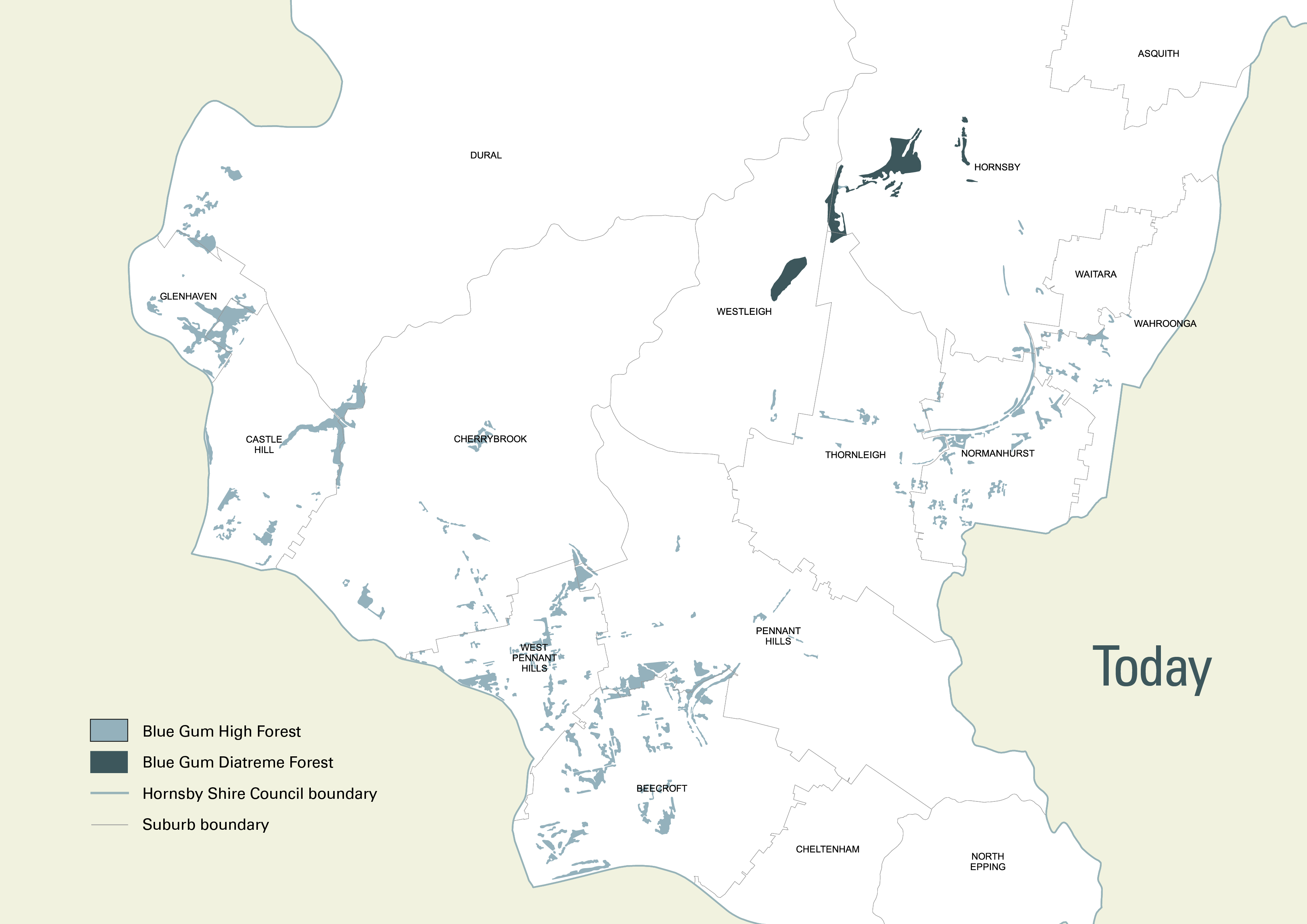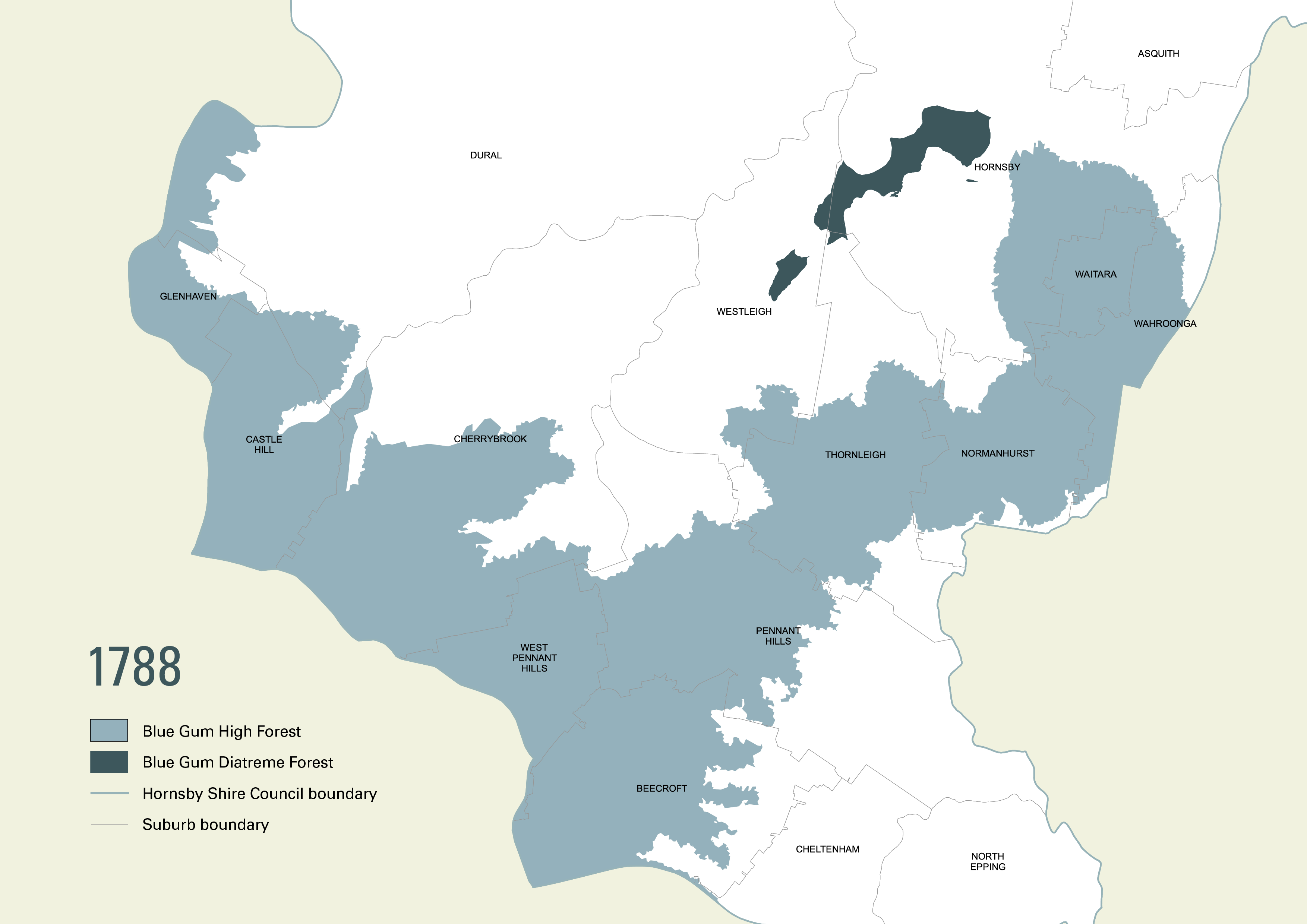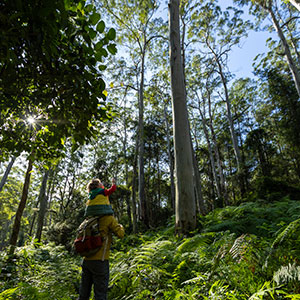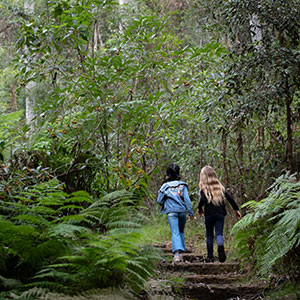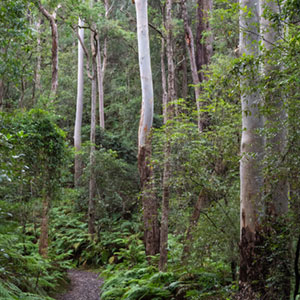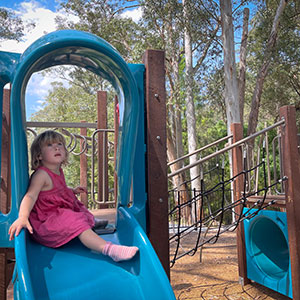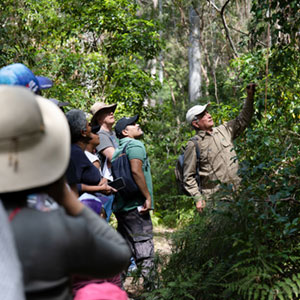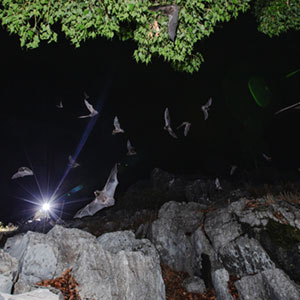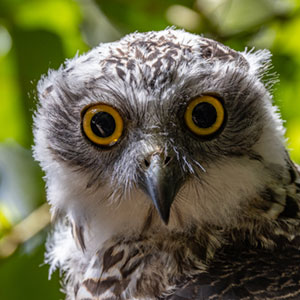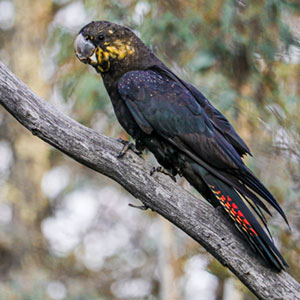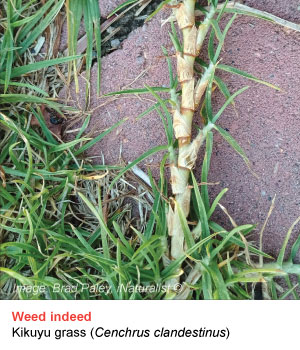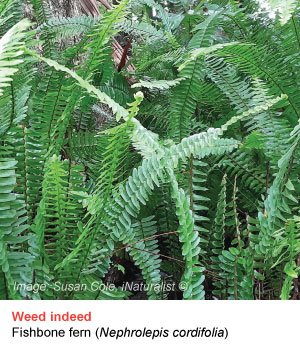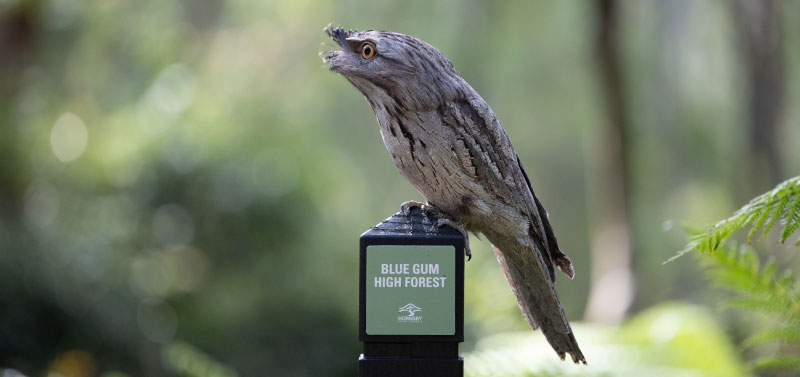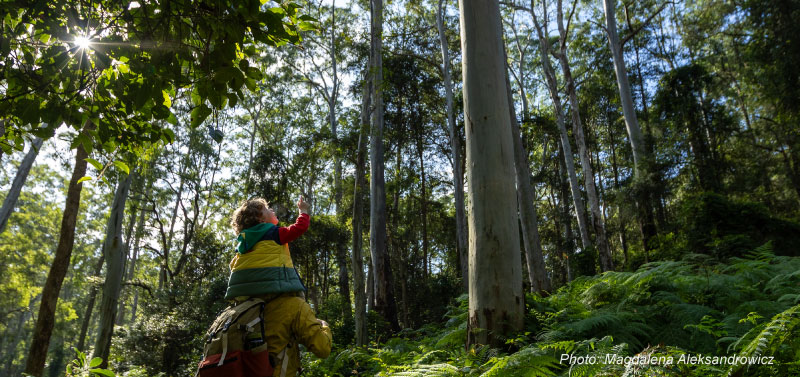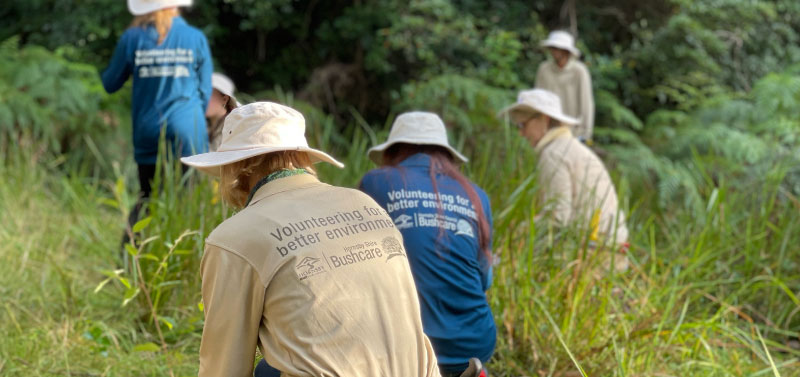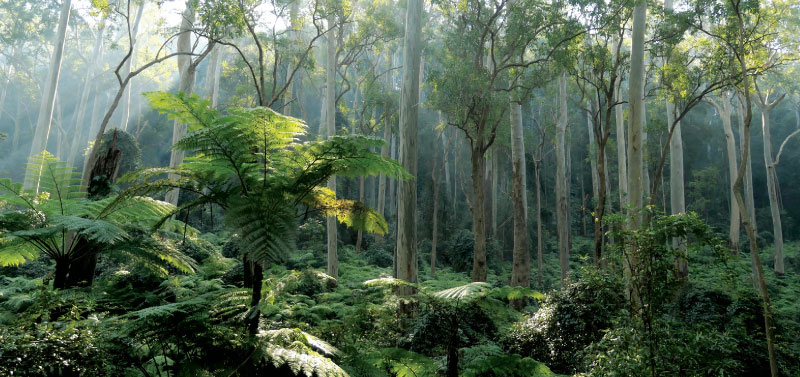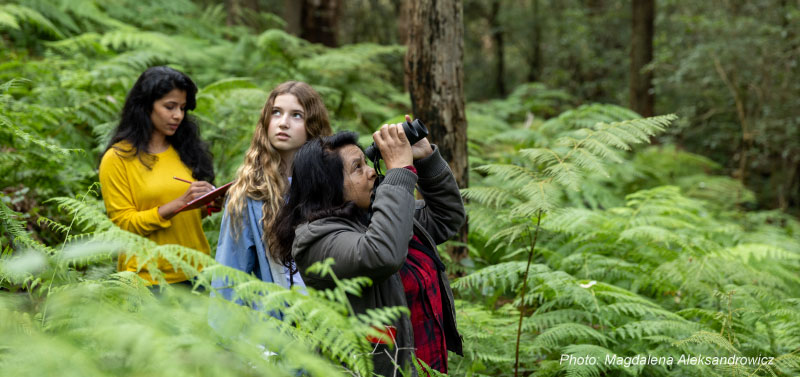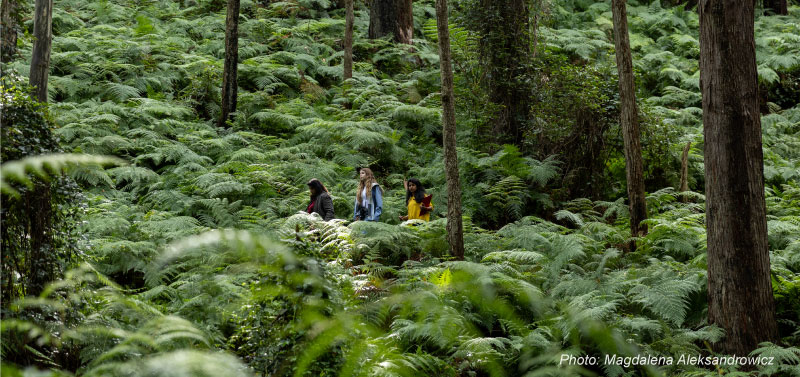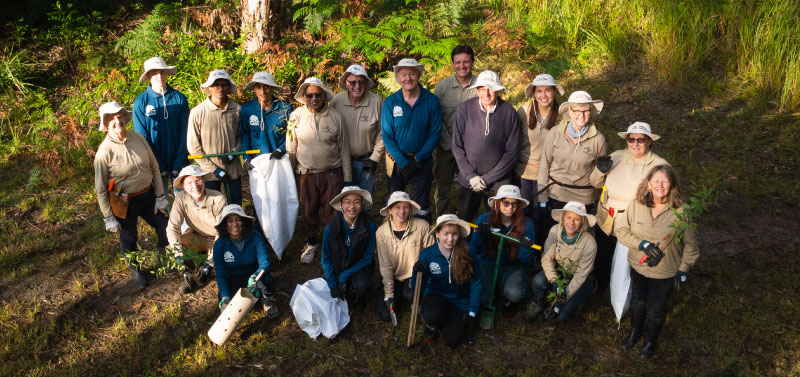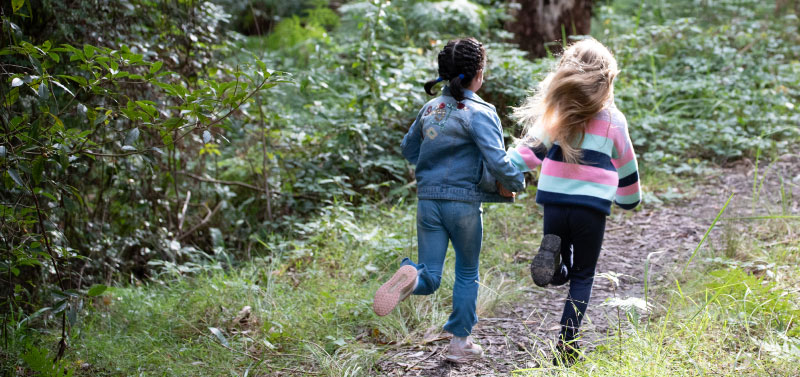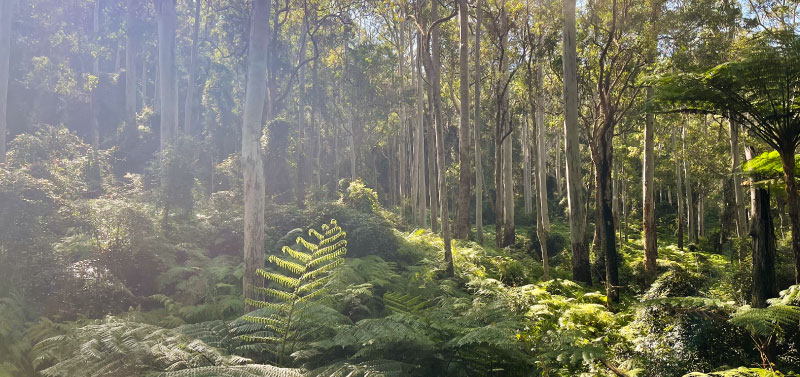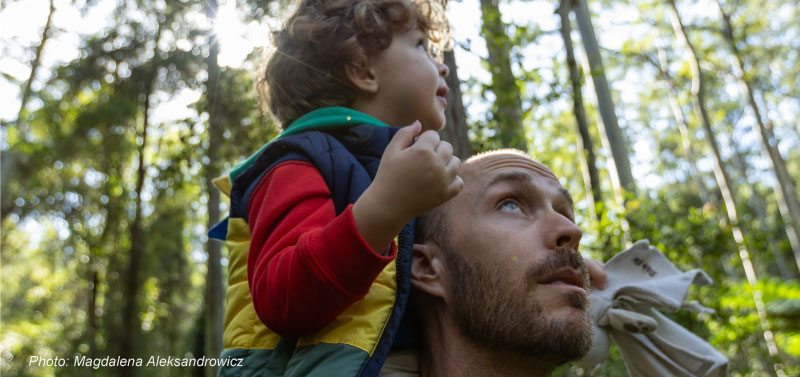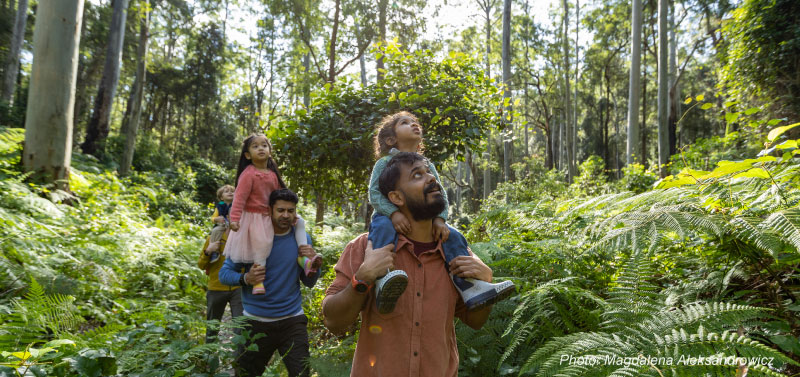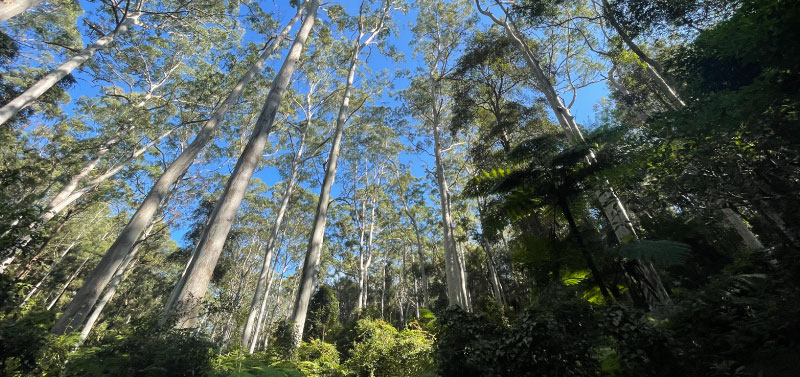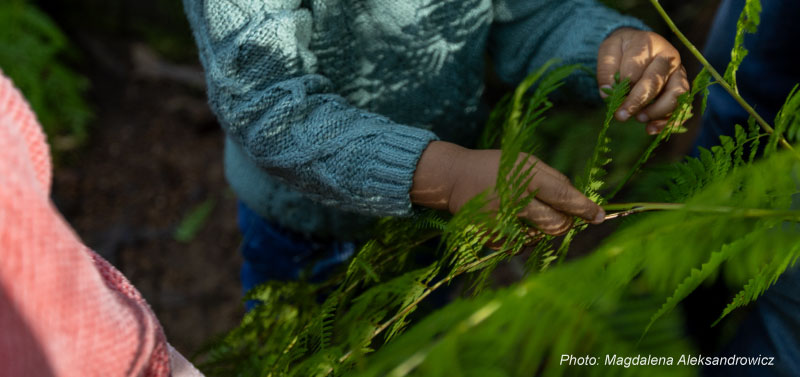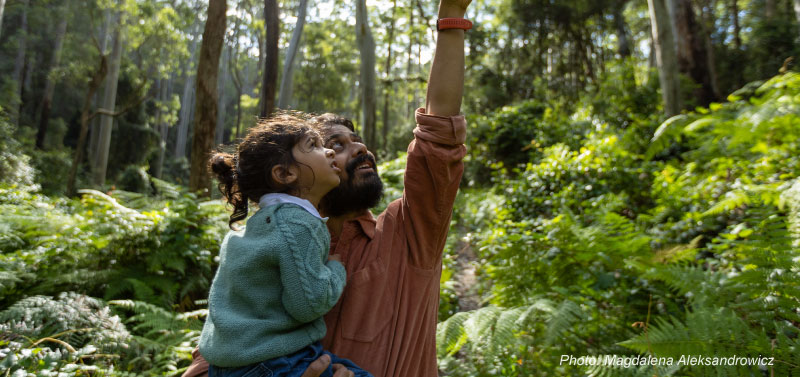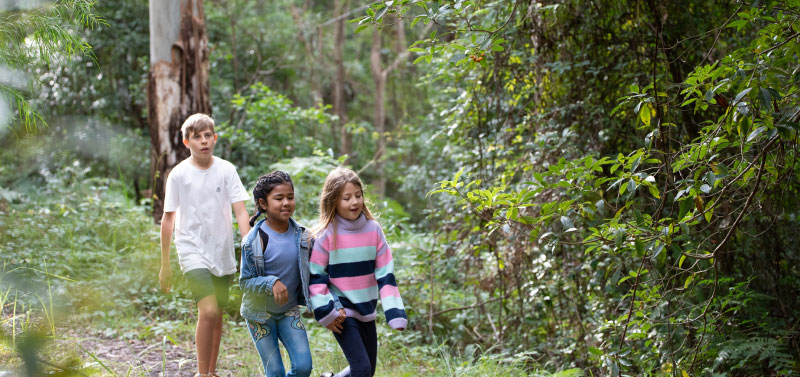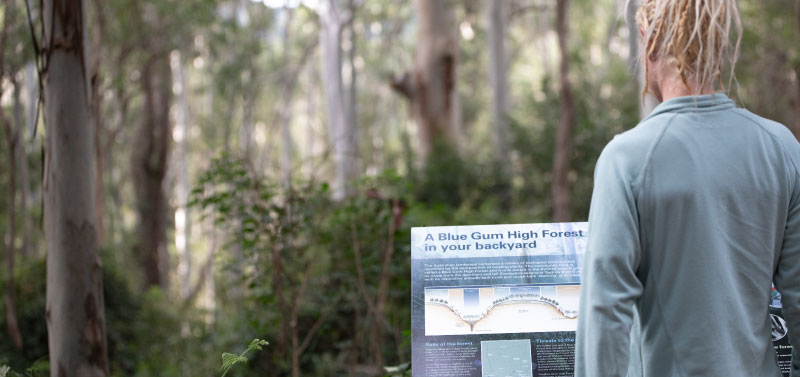Critically endangered
Blue Gum High Forest
Only 5% remains…
Come visit, fall in love and help us protect our Blue Gum High Forest.
Let's all #SayHighForest
Move the slider to compare Blue Gum High Forest over time.
A visit is a must!
So much to learn, so much to love
Tall and handsome Sydney Blue Gums (Eucalyptus saligna) tower up to 50 metres high with smooth, blueish-grey trunks and their signature brown bark “socks” at their base. They’re one of the most common tree species making up the ecological community known as 'Blue Gum High Forest' and you will often find them contrasted amongst luminescent green fernery and other forest stunners.
So Rare
Only an estimated 5% of the original Blue Gum High Forest remains. This ecological community has specific soil and rainfall requirements that limit where it can occur. The critically endangered Blue Gum High Forest’s survival is overwhelmingly dependent on Hornsby Shire and its people.
Where love grows
Blue Gum High Forest grows in 14 suburbs within Hornsby Shire, in and amongst the places where over 99,000 people live. If you live in or near these suburbs, then Blue Gum High Forest is your neighbour: Arcadia, Beecroft, Castle Hill, Cherrybrook, Dural, Galston, Glenhaven, Hornsby, Normanhurst, Pennant Hills, Thornleigh, Wahroonga, Westleigh, West Pennant Hills.
Why does it only grow in a third of Hornsby Shire’s suburbs?
Blue Gum High Forest has specific soil and rainfall requirements which, when added together, limit where it can grow. Some trees in a Blue Gum High Forest need rich, deep soils to support their straight and tall growth. Such soils form from weathered shale rock or have volcanic origins. The second essential ingredient is a rainfall total above 1100mm (on average) per year. Where Hornsby Shire’s suburbs have this soil and rainfall combination, and where it hasn’t been cleared, you will find Blue Gum High Forest.
Jurassic Park on your doorstep
Hornsby Shire contains 40% of the world’s Blue Gum High Forest! Yet, within some of our patches grows an even rarer sub-type of Blue Gum High Forest called 'Blue Gum Diatreme Forest'.
This 14-hectare sub-forest community of outstanding majesty is so rare it can only be found in Hornsby Valley or nearby Fox Valley. It gets its name because it occurs on soils formed from eroding diatremes - volcanic pipes of magma that forced their way to the surface some 200 million years ago when dinosaurs roamed the Earth.
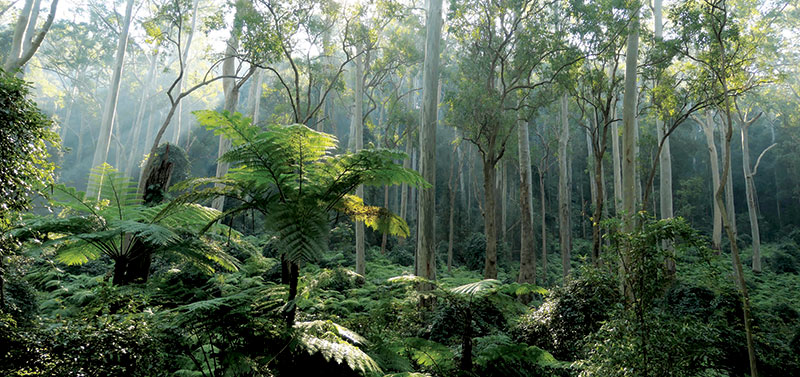
Blue Gum High Forest is not just a stand of majestic trees. Rather, it's a unique and complex community of plants, animals, fungi, and other organisms. Everything living in or visiting an ecological community contributes to its health.
Ecological communities are created by nature over thousands of years, so once it is gone, it cannot be replaced.
Meet your (wild) neighbours
Many species making up Blue Gum High Forest are quite common, however others, such as the powerful owl, glossy black-cockatoo, and several microbats are currently threatened with extinction.
Photo credits: 1. Large bent-winged bats (Miniopterus orianae oceanensis) - Alex Pike/DCCEEW
2. Powerful owl (Ninox strenua)
3. Female glossy black-cockatoo (Calyptorhynchus lathami)
Protecting threatened wildlife = protecting hollows
One key feature of Blue Gum High Forest is the hollows that form in mature trees. These play a vital role in providing homes and nesting sites for many native animals.
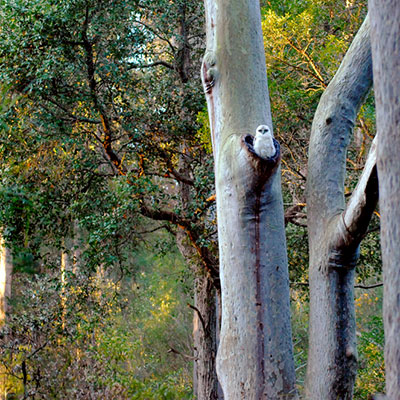 The powerful owl, for example, is Australia's largest owl and its survival depends on large hollows that usually only form in trees at least 150 years old. Similarly, the glossy black-cockatoo requires large hollows of at least a metre in depth, so it too relies on trees aged over 150 years for breeding.
The powerful owl, for example, is Australia's largest owl and its survival depends on large hollows that usually only form in trees at least 150 years old. Similarly, the glossy black-cockatoo requires large hollows of at least a metre in depth, so it too relies on trees aged over 150 years for breeding.
Due to the former logging industry of Hornsby Valley which sought the timber of the tallest Sydney blue gums; expansive farmland clearing, and ridgeline suburb expansion where Blue Gum High Forest normally thrives, our local wildlife is faced with a critical shortage of large hollow bearing, older trees.
It is crucial, therefore, that we preserve mature tree hollows by protecting standing trees (both living and dead) wherever possible.
Resources
For an in-depth Blue Gum High Forest profile go to the Australian Government’s Species Profile and Threats Database for the Blue Gum High Forest of the Sydney Basin Bioregion Or try the NSW Government’s Threatened biodiversity profile search tool.
When an outpost of the British Empire settled in Sydney some 240 years ago, Blue Gum High Forest quickly became highly regarded for its straight, tall trees and its rich, moist soils. Its trees were felled for their timbers, and the forest was progressively cleared for agriculture. With transport corridors concentrated on the ridge lines where it mainly grows, and with increasingly dense urban development, Blue Gum High Forest was almost squeezed out of existence. Today less than 5% of its area remains, and Blue Gum High Forest is facing an extremely high risk of extinction. In fact, less than 200 hectares of Blue Gum High Forest exists on the entire planet, and the scattered and narrow patches left are under immense pressure.
Blue Gum High Forest is listed by the NSW Government and the Australian Government as a critically endangered ecological community. Once it is gone, it cannot be replaced!
The small amount of Blue Gum High Forest remaining is subject to pressures that threaten its health and survival. Sustainably looked after for tens of thousands of years by traditional custodians, everything changed for Blue Gum High Forest when Europeans arrived in Hornsby Shire. Beginning in the late 1700s, trees were felled for timber followed by wide-spread clearing of the forest for farming. With the construction of railway lines and road expansion, suburbs replaced the once-rural areas. As Sydney's population grew, land-use development continued a-pace and the forest was almost squeezed out of existence. You can find out more by reading Hornsby Thematic History.
Today, Blue Gum High Forest is still under threat from many factors. Left alone and without help, these negative impacts would accumulate, and Blue Gum High Forest could quickly decline and become extinct.
Weeds
Exotic plants, including weeds and garden escapees, constantly enter bushland and can take over all layers of a forest. This is especially the case along bushland edges and waterways, and in small or narrow patches of bushland that are surrounded by development. Think again if you don’t believe there are plants that can overpower the mighty Sydney Blue Gum and other canopy trees. Groundcover weeds such as Wandering Trad (Tradescantia fluminensis) can completely block the light reaching the forest floor. No matter how robust the tree, their seeds and seedlings need space and light to germinate and grow. This can’t happen with a thick blanket of weeds covering the ground.
Stormwater
As deep soils are replaced by concrete and bitumen for roads and footpaths, and buildings and facilities for the Shire’s growing population, there is increasingly less space for rain to be slowly absorbed into the ground where it falls. Now when it rains, urban creeks become raging torrents fed by pipes and gutters channelling water that has fallen on these hard surfaces quickly into our natural waterways and bushland. Along the way, this stormwater will carry with it any seeds or plant parts swept up in its path, loose soils, and nutrients such as fertilisers. With creeks flowing higher and faster than is natural, stormwater can reach far into bushland, laying down nutrient-rich sediments. Many bushland weeds thrive in these conditions and their growth can out-compete the native bushland plants. With much bushland located downslope of developed areas, water shedding directly from neighbouring properties can also give weeds the upper hand on the edges of bushland. Council’s Catchment Remediation Program of the last few decades continues to reduce the magnitude of these impacts. Council’s Water Sensitive Hornsby Strategy assesses the Shire’s water sensitive performance and sets a Vision for 2040.
Dumping
Dumping is where natural or manufactured materials are taken into the forest, or moved within the forest, and left there. Natural materials include soil, rock and garden or tree prunings. Manufactured materials found in bushland include concrete and other building materials, discarded items such as furniture, and waste. Building up land or dumping material on top of the forest’s natural ground surface can starve the soil of oxygen and light. Seeds can’t germinate beyond a certain depth, and roots and other living things below the ground need oxygen to survive. The patch of forest affected cannot regenerate and its health declines.
Clearing
Clearing of Blue Gum High Forest is not just limited to the cutting down of trees but involves the removal or killing of any of the plants (including shrubs, grasses and groundcovers) which make up this unique ecological community. Unauthorised clearing is a threat to the survival of Blue Gum High Forest. It includes private properties encroaching onto public land to create extra space, cutting or poisoning of trees and plants to improve views or access to sunlight or to prevent leaves and branches dropping into properties, track building to access natural areas and concerns about bush fire. Depending on the extent, some of these activities can be authorised by governments, including local Councils and state and national governments. If not authorised, and because of the critically endangered status of Blue Gum High Forest, these clearing activities can be considered illegal.
Clearing of Blue Gum High Forest is exacerbated by the digging up of soil by hand tools or machines. Blue Gum High Forest contains many living things below the ground surface. Digging up soil damages the future of the forest (in the location it occurs) by removing roots and vital stores of seed and the underground stems, bulbs and tubers of various plants. Digging also damages the roots of trees and other plants that grow alongside the cleared area.
Depending on the extent, some clearing activities can be authorised by governments, including local Councils. The reason why approvals may be granted is to provide places for people to live, work and recreate, or to manage risks to life and property. Any approval process requires rigorous environmental assessments, and options must be considered that reduce or eliminate any impacts on the forest.
Disease
Phytophthora and Myrtle Rust are exotic pathogens that damage bushland ecology and cause the death of plants in certain susceptible areas. These diseases can be spread by people moving through bushland and unknowingly picking up pathogens on their shoes and clothes.
Guided by Council’s Biodiversity Conservation Strategy, Council has specialised staff and contractors who work to protect and repair bushland in parks and reserves and in selected unmade road reserves. Bush regeneration contractors restore bushland at around 80 sites across the Shire, including 21 Blue Gum High Forest sites. Bushcare volunteers work at 65 sites across the Shire, guided by specialist site supervisors employed by Council. Twelve (12) of these Bushcare groups work at Blue Gum High Forest sites.
Entrusted with looking after a precious forest teetering on the edge of extinction, Council must carefully assess and plan any work and activities that could damage Blue Gum High Forest in parks and reserves. With the aim being the forest’s long-term survival, Council conducts and supports plant and animal surveys to measure the forest’s health and to keep an eye on its wildlife and other dependents. A sound understanding of each patch of Blue Gum High Forest and its place in the Shire’s wider bushland network is essential. From an environmental impact perspective, the location and design of any proposed tracks and trails, shared pathways, play spaces and stormwater drainage devices (to name just a few) can be guided by survey findings. Options can be considered, and decisions made to ensure protection of critically endangered forests into the future is given the highest priority.
Council warmly invites the community to visit the parks and reserves where Blue Gum High Forest grows to experience its majesty and to appreciate and understand the ways of nature. Critical to the survival of the forest are human interactions that support its health and ongoing sustainability. As for precious works of art like Leonardo da Vinci’s Mona Lisa or Michelangelo’s David, access to and through Blue Gum High Forest must be appropriate and carefully managed.
Help #SayHighForest not "Bye Forest"
There are so many ways we can all help protect Blue Gum High Forest
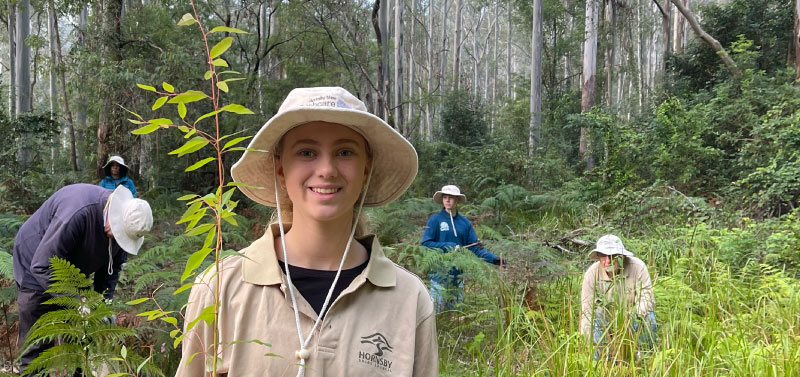
Becoming a Bushcare volunteer is an enjoyable way to learn about Blue Gum High Forest with like-minded people.
There are 13 Bushcare groups working in Blue Gum High Forest. Each group is guided by a specialist site supervisor employed by Council.
Blue Gum High Forest Bushcare Groups
- Beecroft – Cassia Grove – 3rd Monday of the month, 1pm–4pm
- Beecroft – Chilworth Reserve – every Friday, 9am–12pm
- Beecroft – Fearnley Park – 1st Friday of the month, 8am–11am
- Beecroft – Hull Road – 2nd Saturday of the month, 8am–10am
- Beecroft – Observatory Park – 1st Saturday of the month, 9am–12pm
- Castle Hill – Erlestoke Park – 4th Saturday of the month, 9am–12pm
- Cherrybrook – The Lakes of Cherrybrook – 4th Thursday of the month, 9am–12pm
- Hornsby – Ginger Meggs – 1st Saturday of the month, 1pm–4pm
- Hornsby – Rosemead Road – last Sunday of the month, 9am–12pm
- Normanhurst – Kenley Park – 1st Saturday of the month, 1pm–4pm
- Wahroonga – Netherby Street – 4th Monday of the month, 9am–12pm
- West Pennant Hills – Campbell Park – 3rd Saturday of the month, 8am–11am
- West Pennant Hills – New Farm Road – every Monday, 8.30–11.30am
With a variety of days, times and locations available there is sure to be a Bushcare group to suit you.
If you want to help the forest but are short on time, why not come along to a community planting event!
Held on a weekend, community plantings are for everyone, young and old alike. Most events are booking-free, so you can simply turn up and lend a hand for any length of time (between 30 minutes and 2 hours).
Usually located on the edge of bushland in a Council park or reserve, the planting sites are suitable for those with a basic level of fitness and for children (under the supervision of their parent or a carer).
There are roughly three open community planting events held per year, including in rare forests such as Blue Gum High Forest. Sign up to receive Council’s free e-newsletters so you never miss a community planting event, or other great activities in our Shire.
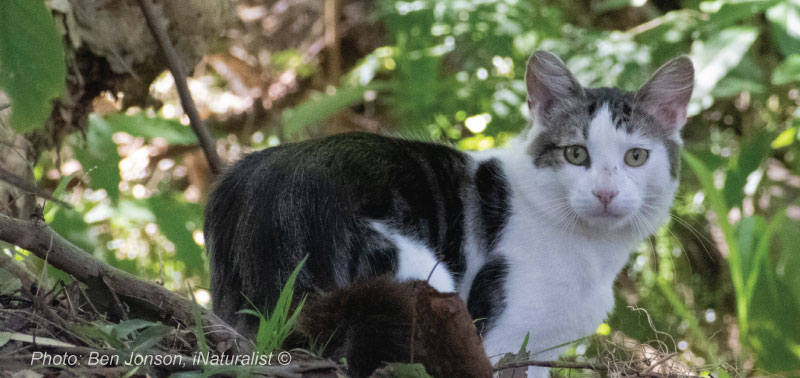
Protect your cat by keeping it within your premises!
Did you know the average lifespan of a cat kept indoors is 12 years, whereas cats allowed to roam outside live an average of three years?
For the safety of our forest’s wildlife it is also best to keep your cat indoors, especially at night.
“Roaming domestic cats kill about 60 million birds a year and feral cats are a major cause of mammal extinction.”
- Federal Government Threatened Species Commissioner (2017)
Cats found in Wildlife Protection Areas can be caught and the owner will incur a penalty of $180 under Section 3.0 of the Act.
Find tips for how to protect your cat and our wildlife in the Wildlife Protection Areas of Hornsby Shire brochure.
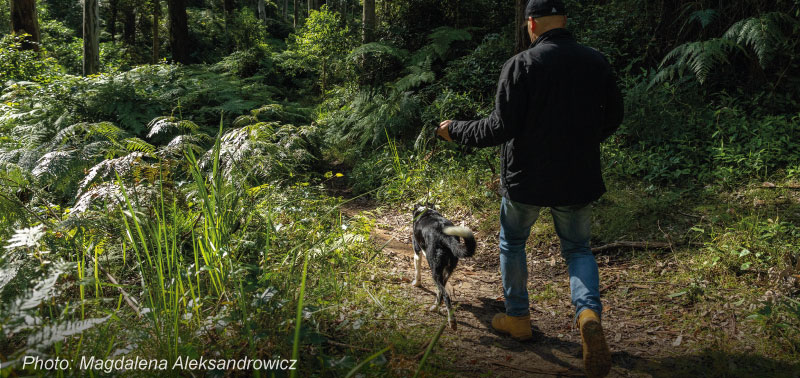
Keep dogs on leads, stick to the managed tracks and trails and remove their droppings when in bushland.
Dogs are NOT permitted to enter national parks in NSW, except for trained assistance dogs accompanying people with a disability. However, they are permitted in Hornsby Shire Council-managed bushland where it is essential that dogs stay on leads, stick to managed tracks and trails, and dog droppings are picked up and disposed of properly, away from the forest.
Why our forests don’t do, dog poo
Removing dog droppings is not simply for the comfort of other walkers. Other reasons to pick up and remove dog droppings include: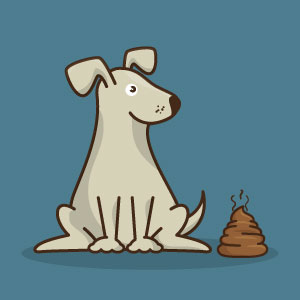
- Dog droppings add substantial amounts of fertilising nutrients to the naturally low-nutrient, native bushland. Overfertilisation reduces biodiversity by significantly boosting the growth of weeds, allowing weeds to drive out other plants (and the wildlife that depends on those plants). Added to the concentrated nutrients, the scratching made by dogs creates disturbed soil areas that further encourage weed growth.
- The nutrients from dog droppings also move in the groundwater and can encourage algae blooms in creeks and other waterbodies.
- Parasites present in dog droppings can live for years in soil where it has been left to break down, risking wildlife infection.
- The scent of dog droppings can scare away native wildlife, throwing the delicate ecosystem further out of balance.
- Dog droppings can attract foxes that kill native wildlife.
Why your dog needs to stay on a lead
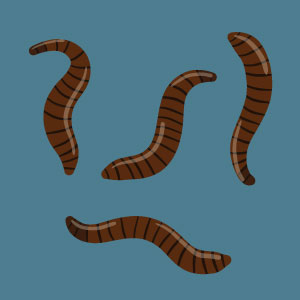 Even if you feel your dog won’t attack wildlife when off leash, the forest’s wildlife will still perceive your dog as a predator and they will become easily scared, modifying their behaviours that lead to a chain reaction, negatively impacting an entire forest ecosystem.
Even if you feel your dog won’t attack wildlife when off leash, the forest’s wildlife will still perceive your dog as a predator and they will become easily scared, modifying their behaviours that lead to a chain reaction, negatively impacting an entire forest ecosystem.
It is critical that your dog not only stays on a lead, but you both keep to Council-managed tracks and trails. When dogs rub against dense trees and shrubbery, or leave their scent by urinating or through droppings, this is enough to disturb native wildlife and further modify their behaviours.
Wildlife that feed, nest or travel on or near ground level are particularly vulnerable to dogs. This includes the beautiful superb lyrebird and the Bassian thrush, who both live in some Blue Gum High Forest areas of Hornsby Shire. If these animals are scared away, then the work they do to keep the ecosystem balanced, (like eating small critters that live on or near the forest floor) does not happen. This means that leeches can rapidly multiply, resulting in an unpleasant forest experience for us humans. More importantly, populations of insects that feed on, and can subsequently kill plants (such as young Sydney blue gum trees), may not be kept in check, endangering the long-term survival of the forest.
Owners of dogs roaming in Wildlife Protection Areas can incur a penalty of $330 under Section 14 of the Companion Animals Act 1998.
Download this Brochure for more info on caring for pets and protecting our wildlife in Wildlife Protection Areas of Hornsby Shire.
Download this list of Hornsby Shire Bushwalks you can do with your dog kept on its lead.
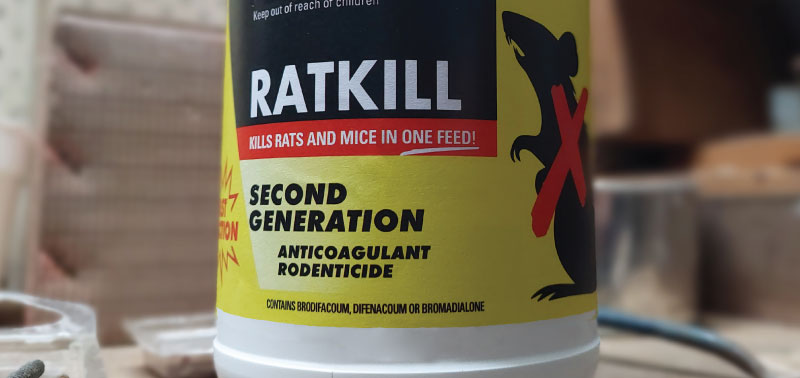 Never use second generation rodent poisons, as they can also kill wildlife, such as owls, which feed on poisoned mice and rats.
Never use second generation rodent poisons, as they can also kill wildlife, such as owls, which feed on poisoned mice and rats.
These rodent poisons are called anticoagulant rodenticides, and although the second generation variety of this product may “kill in just one feed”, the poison lingers in the environment and can continue to poison wildlife, even long after its original victim has perished.
When wildlife (such as the threatened powerful owl) feed on poisoned rodents, they themselves become poisoned. A recent study by Birdlife Australia found second generation rodenticides present in 37 out of 38 livers (97%) of dead powerful owls, often at toxic (60%) and sometimes potentially lethal levels (11%)1
Brodifacoum is the most common ingredient in second generation anticoagulant rodenticides in Australia and in another recent Australian study by Deakin University, it was detected in the livers of 55 out of 60 dead, native predatory birds (92%). 33% were found to have possibly lethal levels and significantly more had “possible toxicity” levels high enough to cause impairment.2
How to identify (to avoid) second-generation mouse and rat poisons*
- You can see the words “Second generation anticoagulant rodenticide”.
- You DO NOT see the words “First generation anticoagulant rodenticide”.
- The product lists either Brodifacoum, Difenacoum or Bromadialone as the active ingredient.
- The pack mentions wording like “Kills with just one feed”.
- The pack is likely to claim, “Fast action” even though the fine print may mention that it is likely to take “on average 4 - 7 days (or longer) to kill rodents after consumption”.
Sign Birdlife Australia’s petition to ask Bunnings to stop stocking second generation anticoagulant rodenticides; or write to your local member asking to change Australian laws
1Read about Birdlife Australia’s study of the impact of second-generation anticoagulant rodenticides on Powerful Owls
2Read about Deakin University’s study about the impact of second-generation rodenticides on predatory birds.
*Read Birdlife Australia’s guide of specific products to buy and to avoid.
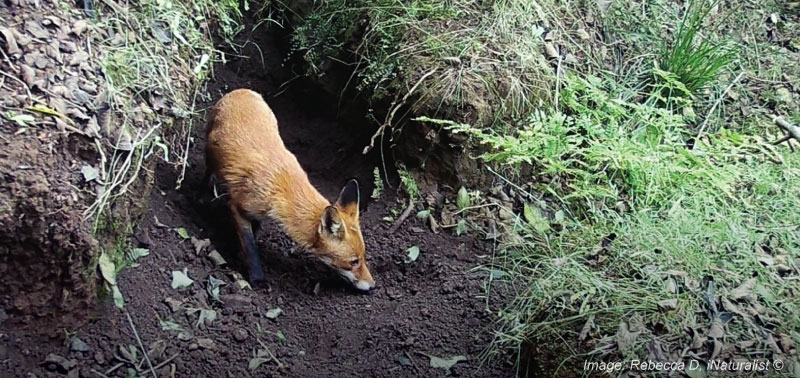
The red fox (Vulpes vulpes), introduced to NSW in the 1870s for recreational hunting, is a significant pest in all areas of NSW, including Hornsby Shire.
Active mostly at night time, these highly efficient hunters can decimate wildlife populations, including regional declines and extinctions of a wide range of native animals. Medium-sized, ground-dwelling mammals (such as wallabies) and ground-nesting birds (such as superb lyrebirds), and freshwater turtles are especially vulnerable to fox predation.
If you see a red fox, please report it using FoxScan. Information you record can be used to manage foxes more effectively and reduce the damage they cause.
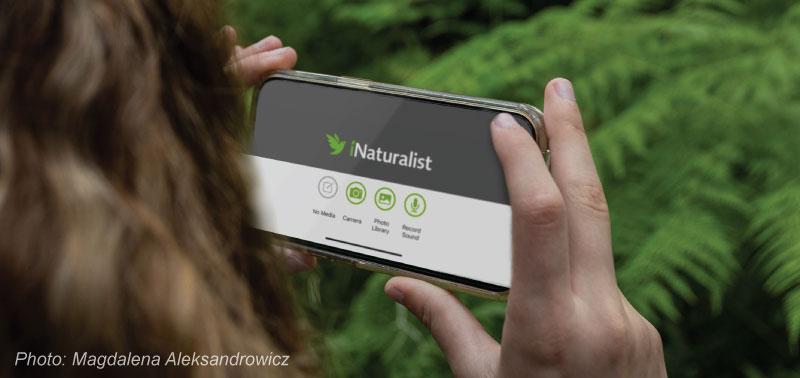
When visiting the forest, get your camera or smartphone out and record some of the biodiversity you encounter with iNaturalist. Hornsby Shire Council recommends using the iNaturalist.org website or the iNaturalist app (available on the iNaturalist.org website).
iNaturalist is a crowd-sourced identification tool to help you, scientists and members of the community learn more about the environment. Anyone can use iNaturalist to record and easily identify the plants, animals, and other living things in your photos and audio recordings.
It is available for researchers or for anyone wanting to find out more about nature. Confirmed observations become part of the Atlas of Living Australia, hosted by the CSIRO.
It’s very easy to use and is a great learning tool, for absolute beginners right through to experienced naturalists. It even has the capacity to identify unseen living things. For example, you can submit evidence such as photos of animal tracks, nests and scats, and audio recordings.
Visit the Hornsby Shire Council iNaturalist page
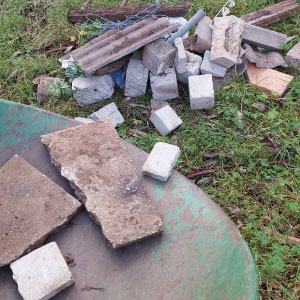
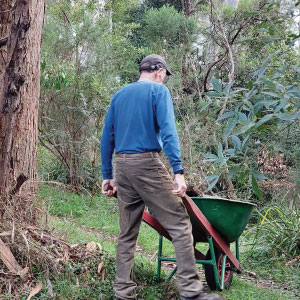
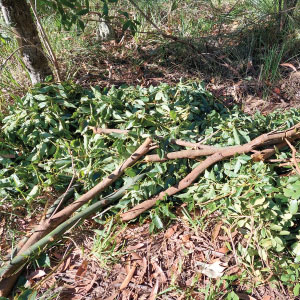
Never dump construction materials, landscaping and vegetation or rubbish in bushland - penalties apply. Call 13 70 30 to report dumped waste.
Dumping material on top of the forest’s natural ground surface can starve the soil of oxygen and light. Seeds can’t germinate without oxygen and roots and other living things below the ground need oxygen to survive. The patch of forest affected cannot regenerate and its health declines.
In addition, if landscaping and vegetation are dumped, this will likely spread weeds, further harming the forest and damaging its ecosystem.
Don’t simply assume your gardening or building contractor will do the right thing and dispose of materials and vegetation correctly. Always check.
It is an offence to be both the transporter and the owner of dumped waste, disposed of anywhere that is not a lawful waste facility.
Illegal dumping is punishable by on-the-spot fines, court-imposed penalties, and in some instances by imprisonment. Currently, on-the-spot fines for illegal dumping range from $2000 for minor offences to $8000 for more serious offences.
Go to our Illegal dumping webpage for more info.
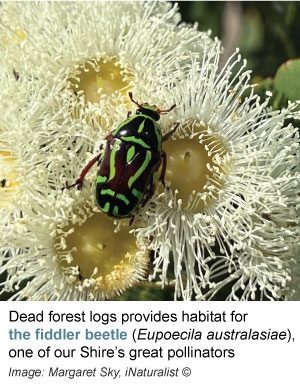
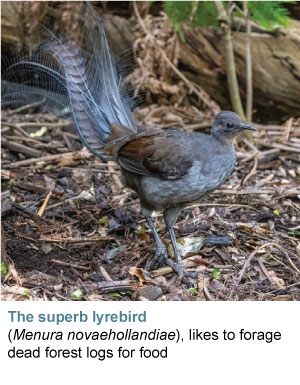
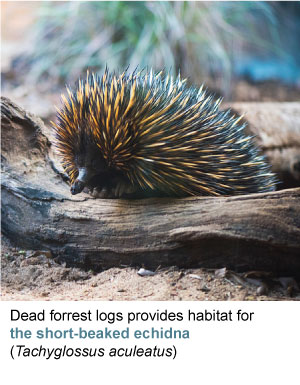
Don’t remove wood from the forest for firewood or for any other reason.
Even when wood is “dead” it is an essential part of the forest ecosystem. Dead wood provides:
- habitat for wildlife, such as the echidna
- food for insects such as the fiddler beetle, one of our Shire’s important pollinators
- vital nutrients in the soil to feed the forest’s many plants and trees when the dead wood decomposes.
Further to this, the insects that depend on dead wood to survive, themselves become an important part of the ecosystem’s food chain. For example, insects feeding on dead wood become food supply for the lyrebird attracting more wildlife to the area.
Report to Council any activities you suspect might be damaging Blue Gum High Forest.
Call (02) 9847 6666 or email hsc@hornsby.nsw.gov.au.
If you live near the forest, there’s even more you can do to help preserve it:
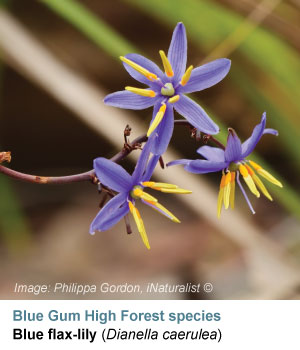
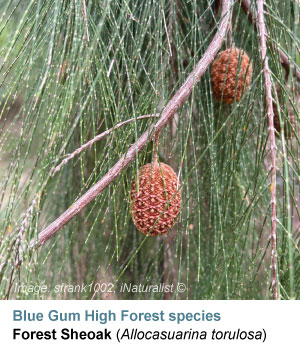
Plant some of the forest’s native species, such as forest oak (Allocasuarina torulosa), muttonwood (Myrsine variabilis) flax lily (Dianella caerulea) and wonga wonga vine (Pandorea pandorana) in your garden. This will help attract birds, mammals and butterflies.
Hornsby Shire ratepayers can take up the offer of free plants from Warada Ngurang Community Nursery, where volunteers and staff propagate the plants, both big and small, that grow in a Blue Gum High Forest. Pop them in your garden and you will be helping creatures such as moths, butterflies and native bees that feed on and help pollinate the forest’s plants. You will also be helping wildlife such as the rare glossy black-cockatoo, who depends on a handful of trees for its food, including the forest oak (Allocasuarina torulosa), a small tree that grows in Blue Gum High Forest.
Below is a list of tree and plant species native to Blue Gum High Forest that you could plant in your garden or on rural acreage. Most are grown at Warada Ngurang Community Nursery.
40 Blue Gum High Forest species
Subscribe to Hornsby Shire Council’s e-newsletter to never miss a free native plant giveaway.
It is extremely hazardous to throw lawn clippings and other vegetation into native bushland as it very often carries weeds and seeds - a significant threat to our fragile bushland. Our fantastic Bushcare volunteers spend hours every week removing weeds from bushland. You could help them and the forest by not letting your grass clippings or other garden vegetation enter bushland.
Mowing underneath Blue Gum High Forest trees prevents seedlings from establishing. Hand weed or carefully spot-poison weeds instead. Mowing through native forest grasses or understory destroys a vital component of the Blue Gum High Forest ecosystem. Never extend your yard boundaries into bushland reserves, as it will likely eliminate the forest grasses, ferns and other plants that belong to the ecosystem.
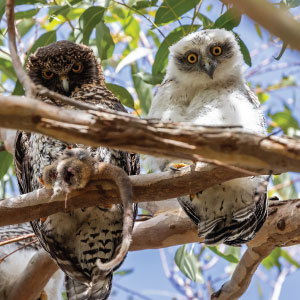
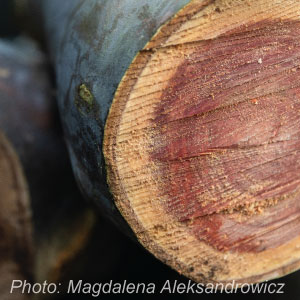
Please look after the trees of Blue Gum High Forest. If you are concerned about a tree on your, or your neighbour’s, property, please visit Trees on Private Property and find out about management options and whether a permit is required for any tree work. It is particularly important to avoid removing standing trees with hollows (alive or dead) and any branches or dense shrubbery near the hollows. This is the habitat that our precious forest owls and parrots need for breeding, and without these natural hollows we will lose them from our suburbs.
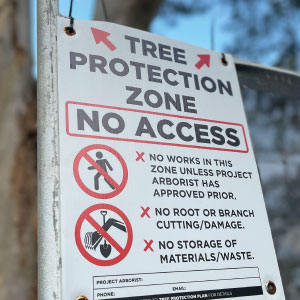
When pursuing building activities or landscaping, all efforts should be made to protect any trees, in particular Sydney blue gums and other canopy trees of Blue Gum High Forest. An arborist can assist to ensure these are kept in a safe condition.
Remove weeds from your own garden to stop them spreading into the Blue Gum High Forest.
Some of the most threatening weeds to the Blue Gum High Forest include:
Rainwater falling onto hard surfaces, such as buildings and driveways, is unable to soak into the ground. This water, known as ‘stormwater run-off’, is channelled into stormwater pipes or flows quickly over the hard surface and into adjacent areas. Run-off into Blue Gum High Forest, or any bushland area, can cause soil erosion, prolific weed growth and native plant death due to excess moisture and nutrients.
Installing a raingarden on your property can help the forest stay healthy. Raingardens protect forests and bushland by capturing, slowing down and filtering stormwater run-off before it enters our precious natural areas.








